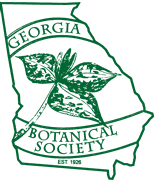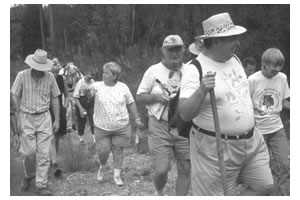
The Georgia Botanical Society
Dedicated
to the study and preservation of Georgia's wild, native,
rare and endangered wildflowers and plant life
You've reached an old page of our web site. Please visit www.gabotsoc.org for our current site.
Articles-Places: Prairies of Floyd Countyclick here for printer-friendly version
September 14, 2002
 Sixteen
enthusiastic Bot Soccers met at scenic Rolator Park in Cave Spring anticipating
a wonderful excursion to several of the "famous" Floyd County
prairies, studied over the last decade by Jim Allison, and by Richard Ware,
who was our terrific field trip leader. The meeting site was near a cave
entrance, evidence that soft sedimentary rock such as limestone was in the
area. Many prairie sites in the Great Plains and in the Black Belt of Mississippi
and Alabama (and central Georgia!) are underlain by limestone or calcareous
material and are characterized by basic rather than acid soils. As a field
trip participant, and being a native of Mississippi, I was particularly
interested in encountering plants common to both the Black Belt and Floyd
County prairies. Most of all, I wanted to observe plants unique to this
corner of the state (where Georgia is concerned), such as the rare whorled
sunflower (Helianthus verticillatus). The overcast skies made the
temperature quite pleasant for most of the outing. Richard emphatically
stated (with much humor) that this was unusual for a Bot Soc trip to the
prairies, so we all felt like we were getting the royal treatment.
Sixteen
enthusiastic Bot Soccers met at scenic Rolator Park in Cave Spring anticipating
a wonderful excursion to several of the "famous" Floyd County
prairies, studied over the last decade by Jim Allison, and by Richard Ware,
who was our terrific field trip leader. The meeting site was near a cave
entrance, evidence that soft sedimentary rock such as limestone was in the
area. Many prairie sites in the Great Plains and in the Black Belt of Mississippi
and Alabama (and central Georgia!) are underlain by limestone or calcareous
material and are characterized by basic rather than acid soils. As a field
trip participant, and being a native of Mississippi, I was particularly
interested in encountering plants common to both the Black Belt and Floyd
County prairies. Most of all, I wanted to observe plants unique to this
corner of the state (where Georgia is concerned), such as the rare whorled
sunflower (Helianthus verticillatus). The overcast skies made the
temperature quite pleasant for most of the outing. Richard emphatically
stated (with much humor) that this was unusual for a Bot Soc trip to the
prairies, so we all felt like we were getting the royal treatment.
Our first stop was to some dry prairie openings along Jefferson Road west of the town of Cave Spring. Despite the rather severe drought experienced earlier in the year, many of the fall bloomers did not seem adversely affected. To our surprise, the prairie openings were a riot of color, with golden hues provided by narrow-leaved sunflower (Helianthus angustifolius), narrowleaf silkgrass (Pityopsis graminifolia), gray goldenrod (Solidago nemoralis), and especially tickseed sunflower (Bidens polylepis), among others. Species with lavender to purple colored flowers included grass-leaved blazing star (Liatris graminifolia) and creeping aster (Eurybia surculosa).
Composites with white inflorescences present were rice-button aster (Symphyotrichum dumosum), white-flowered goldenrod (Oligoneuron album), and roundleaf thoroughwort (Eupatorium rotundifolium). After exploring the dry prairie openings, the adjacent floodplains of several creeks, including Mud Creek and Kanady Creek were investigated. Several grasses were out in full-force in the openings, including little bluestem (Schizachyrium scoparium), Indian grass (Sorghastrum nutans), switchgrass (Panicum virgatum), purple lovegrass (Eragrostis spectabilis), river oats (Chasmanthium latifolium), and the towering sugarcane plumegrass (Saccharum giganteum).
All of these reminded us that grasses can be quite spectacular when in bloom (yes, bloom!) and that some are good candidates for landscaping as opposed to some exotic grasses like Chinese silvergrass (Miscanthus sinensis) or giant reed (Arundo donax). Sedges with edges like marsh flatsedge (Cyperus pseudovegetus) were located along the creek. Lanceleaf ragweed (Ambrosia bidentata), an unusual wind-pollinated composite more common west of Georgia, was found on the roadside. A brilliant cardinal flower (Lobelia cardinalis) was spotted along the creek, and other plants such as rough-leaf goldenrod (Solidago rugosa) and sneezeweed (Helenium autumnale) were conspicuous in this habitat.
Most interesting to me in the openings here and in the transition to the floodplains were prairie dock (Silphium terebinthinaceum), prairie coneflower (Ratibida pinnata), Culver's root (Veronicastrum virginicum), stiff goldenrod (Oligoneuron rigidum), and prairie milkweed (Asclepias hirtella), all of which reminded me of Black Belt prairie flora. A number of "Mississippi River floodplain" plants were present along the creeks, such as overcup oak (Quercus lyrata), lace-pixies (Leucospora multifida), and a species of seedbox that lacks petals (Ludwigia glandulosa).
Highlights of the day in the creek floodplains were the rare spreading yellow false foxglove (Aureolaria patula), swamp thistle (Cirsium muticum), and the unusual heartleaf plantain (Plantago cordata) that grew in heavy clay right along the banks of the creek. The false foxglove is a rare species mostly inhabiting calcareous river and creek bluffs in a narrow range from middle Kentucky and middle Tennessee to northwestern Georgia. It is so rare that even few expert botanists have seen it in the wild! The swamp thistle is more common in states north of Georgia, and, as its name indicates, frequents wetlands such as calcareous fens and bogs. The heartleaf plantain is rare throughout the Southeast, and it has been cited as intolerant of much habitat disturbance, such as excess sediment deposition or pollution in the streams it inhabits.
After lunch we headed for the Grand Prairie and along the road we noticed many species characteristic of prairies; and one of these, prairie lion's foot, or barbed rattlesnakeroot (Prenanthes barbata), was caught at peak bloom and was truly spectacular. Prairie lion's foot is an extremely rare species; in Georgia, it is known only from the calcareous areas of Floyd County. Other plants observed nearby were the rare smooth aster (Symphyotrichum laeve var. concinnum), New England aster (Symphyotrichum novae-angliae), three species of blazing star (Liatris aspera, L. squarrosa, and L. squarrulosa), and the whorled milkweed (Asclepias verticillata). Grasses occurring in this general vicinity were prairie threeawn (Aristida oligantha), big bluestem (Andropogon gerardii), bushy bluestem (Andropogon glomeratus), and a species of dropseed (Sporobolus vaginiflorus), all of which are also common in the Black Belt prairies.
When we got to the Grand Prairie, we could hardly believe our eyes. The habitat was naturally very open (essentially treeless) and glade-like, quite an unusual sight in north Georgia. There was an abundance of herbaceous plants growing in the thin soil above the calcareous outcrop, and species diversity appeared to be higher than in surrounding areas. Many plants were no longer blooming, but we did find a type of wild petunia (Ruellia humilis) characteristic of barrens such as this and also a really nice individual of blue hearts (Buchnera americana). The fruiting heads of two rare composites, wavyleaf purple coneflower (Echinacea simulata) and Mohr's Barbara's buttons (Marshallia mohrii), dotted the landscape, indicating that healthy populations of both species were present in this unique habitat.
The wet prairie was probably even more stunning than the Grand Prairie during our visit. Individuals of the whorled sunflower (Helianthus verticillatus) towered above us, and their golden inflorescences were already open. We counted the rays on several of the heads and came up with thirteen every time, which is the usual number for the species. There were usually three or four leaves per whorl, and the leaves alternated in the inflorescence. Stems often grow over four meters high! Whorled sunflower was first discovered in western Tennessee in 1892, and it was believed to have vanished until it was rediscovered about a century later by Richard Ware in northwestern Georgia, by Jim Allison and Alfred Schotz in northeastern Alabama, and by Carl Nordman at a different site in western Tennessee. Our field trip leader found the first plants observed in over 100 years!
Other rare plants growing in the wet prairie with the whorled sunflower included the very aromatic Virginia mountain mint (Pycnanthemum virginianum), prairie loosestrife (Lysimachia quadriflora), and the diminuitive Thorne's beaksedge (Rhynchospora thornei). And then Max Medley, Richard Ware, and I noticed an unusual goldenrod growing intermixed with individuals of stiff goldenrod (Oligoneuron rigidum). We knew it was different, but we could not immediately put a name on the plant. The inflorescence was similar to that of the stiff goldenrod's, but the principal stem leaves were very long, narrow, and drooping. Quick and dirty keying in the field brought us to Solidago uliginosa, but that did not fit, either. Jim Allison, later the same month, keyed a specimen to Solidago riddellii (=Oligoneuron riddellii), a species characteristic of moist prairies in the Midwest south to Ohio and Arkansas. As it turns out, this goldenrod had never been reported from Georgia! Jim Allison then sifted through some herbarium specimens of goldenrods he had collected from the Floyd County prairies in recent years and found he had discovered another population along Kanady Creek, the first from Georgia!
Just as we were leaving the wet prairie, it started to rain. Many members of our group went home at this time, and the trip definitely lived up to and exceeded their expectations (especially considering the drought conditions). Those equipped with caps and/or raincoats, and who could not wait for more, persisted and explored a nearby dry prairie with Richard. Two of the most interesting plants here were side oats grama (Bouteloua curtipendula), more common to the west in the Black Belt region, and small blue wild indigo (Baptisia minor var. aberrans), another rare species characteristic of regions with limestone-derived soils. Dry woods in the vicinity of these prairies harbored a population of bastard toadflax (Comandra umbellata), a rather uncommon plant in Georgia with a most unfortunate common name. Species in the plant family to which it belongs are parasitic. After visiting this site, we all thanked Richard for a wonderful field trip.
The Floyd County prairies are floristically unique and are considered a top priority for conservation efforts. The more well-developed prairies are like "islands" surrounded by plant communities more typical of the Ridge and Valley physiographic region, and they are sites of high plant diversity as well as refugia for rare and endangered vascular plant species. I was relieved to learn that these botanical gems are being protected and managed by The Nature Conservancy; and I, as well as many other field trip participants, left for home with the hope of returning, especially during different parts of the growing season.
Reported by Wayne Morris of Dahlonega, GA
Anita Reaves, Membership Chair
770-827-5186
All contents
of this website(except where otherwise noted) ©2002-2007 Georgia Botanical
Society.
All rights reserved.
The Georgia Botanical Society is a private non-profit organization under IRS
501(c)3, Founded in 1926.
Questions, comments or problems with this website, please contact: webmaster@gabotsoc.org
Home | Newsletter | Field Trips | Tipularia | Links | Articles | Contact Us | Join!